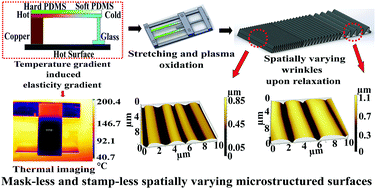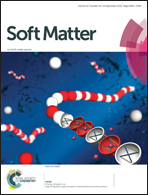Tailored topography: a novel fabrication technique using an elasticity gradient
Abstract
A facile methodology to create a wrinkled surface with a tailored topography is presented herein. The dependency of the elasticity of poly(dimethyl)siloxane (PDMS) on the curing temperature has been exploited to obtain a substrate with an elasticity gradient. The temperature gradient across the length of PDMS is created by a novel set-up consisting of a metal and insulator connected to a heater and the highest usable (no degradation of PDMS) temperature gradient is used. The time-dependent temperature distributions along the substrate are measured and the underlying physics of the dependence of the PDMS elasticity on the curing temperature is addressed. The PDMS substrate with the elasticity gradient is first stretched and subsequently oxidized by oxygen plasma. Upon relaxation, an ordered wrinkled surface with continuously varying wavelength and amplitude along the length of PDMS is obtained. The extent of hydrophobicity recovery of this plasma oxidized PDMS with varying elasticity has been studied. The change in the wavelength and amplitude of the regular patterns on the substrate can be controlled by varying operational parameters like applied pre-strain, plasma power and the heater temperature. It has been found that the spatial distributions of the topography and the hydrophobicity collectively decide the resultant wettability of the substrate. Such surfaces with gradients in the substructure dimensions demonstrate different wetting characteristics that may lead to a wide gamut of applications including droplet movement, cell adhesion and proliferation, diffraction grating etc.



 Please wait while we load your content...
Please wait while we load your content...